Our guest today is John at from the Bartolini kitchens
John’s engaging stories and shared family recipes are like reading a letter from a friend. I rarely sit down to read his posts without coffee in hand, just to remind myself to linger.
I have often thought how fun it would be to step into his kitchen for a long chat while rolling out fresh pasta for dinner—he makes it look so easy!
He is also a fearlessly cheesy. I mean, he makes homemade cheese look easy too.
If you’ve never attempted such a feat, I recommend starting with his ricotta recipe, it’s simple and delicious. Never worked with ramps before? John will show you how with this Ramps Pesto.
It is so quick to make, you’ll have it ready before the pasta is done boiling. After dinner, relax as you browse from the Bartolini kitchens for even more satisfying recipes.
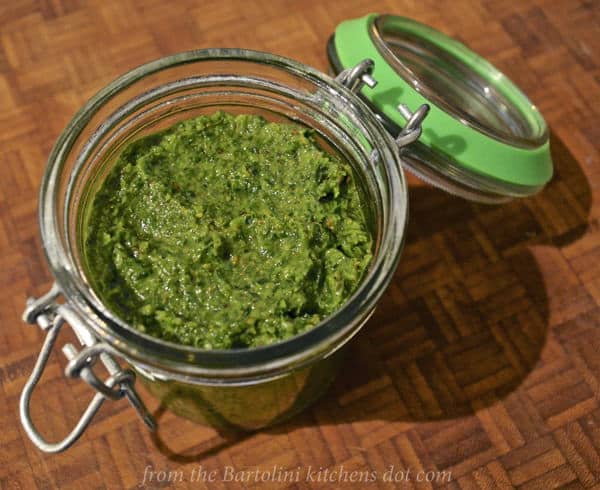
Forget Garganelli, Today We’re Making Ramps Pesto
Good morning to the followers and friends of Judy and this wonderful blog, as well as to my own blogging family. Savoring Today, is an excellent blog, one that sets the bar pretty high for the rest of us and, as a long-time subscriber, I’m honored to be here today as guest host. My name is John, “ChgoJohn”, and I maintain the blog, from the Bartolini kitchens.
At its heart, my blog is a repository for my family’s stories and recipes, some of the latter haven’t been prepared in decades. With an enormous amount of help from Mom’s Sister, “Zia“, as Master Chef, Instructor, and Family Historian, this blog is our gift to the youngest and future members of our family. So, thank you, Judy, for offering me the opportunity to guest host and introduce my family and recipes to your readers. I think I can speak for everyone when I say that it is such great news to hear that your recovery is progressing so well. I can’t wait to see you back here once again, sharing more of your fantastic recipes.
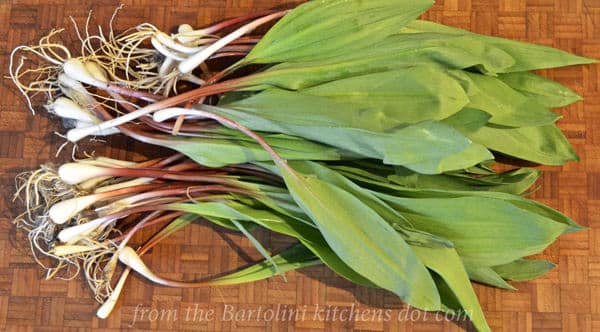
Today was supposed to be a post demonstrating how to make garganelli, but last week I saw ramps were available through a local CSA. Rather than wait for our farmers markets to re-open for the season, I jumped at the chance to make this pesto recipe.
Ramps are a wild member of the onion family. This variety has a very short growing season, about 6 weeks in all, and grows only in North America, east of Manitoba, Minnesota, and Mississippi River, and north from Alabama to Nova Scotia.
As you can well imagine, they were once far more available than they are today. In fact, one theory suggests that my city’s name, Chicago, is derived from the Algonquian word for smelly onions, shikaakwa, (chicagou).
At that time, the area surrounding the Chicago River was rich with wild ramps. Today, with their popularity at an all-time high, people must exercise restraint when harvesting or ramps will become less and less available.
Once trimmed, the entire ramp is edible, leaves and all, and some describe their mild taste as a cross between leeks and garlic. Ramps can be served in many ways: in omelets, dumplings, pickled, sautéed with vegetables, in salads, and, of course, with pasta. In fact, two years ago, I shared a recipe for Fettuccine with Asparagus, Artichokes, and Ramps.
The one rule to follow when presented with ramps is to use them as quickly as possible. Last year, I bought some that had been kept fresh with the bulbs submerged in a jar half-filled with water, as one would do with cut flowers.
I duplicated that at home and the leaves were a wilted mess by the time I got to Michigan 4 days later. Not knowing how truly fresh those ramps were, I’m not entirely certain that this method was the problem.
The ramps used here arrived a little damp in plastic bags. I immediately removed them, wrapped them in paper towels, and stored them in my fridge’s vegetable crisper. 2 days later, they were still very fresh, though I did have to trim away about 3 wilted leaves.
Would they have been in better shape than last year’s ramps after four days? I have no idea and see no reason to risk any ramps finding out. Again, the sooner you use them the better.
As you’ll soon see, I used only ramps in today’s recipe and, as a result, the pesto has a wonderful earthy flavor. If that’s not for you, however, you can easily add parsley or basil leaves to the mix.
Similarly, if you aren’t a fan of walnuts, pine nuts (pignoli) or pistachio nuts may be used. If you can’t get ramps in your area, try using spring garlic or baby leeks, instead. Use as much of the greenery as possible, augmenting it with basil or parsley.
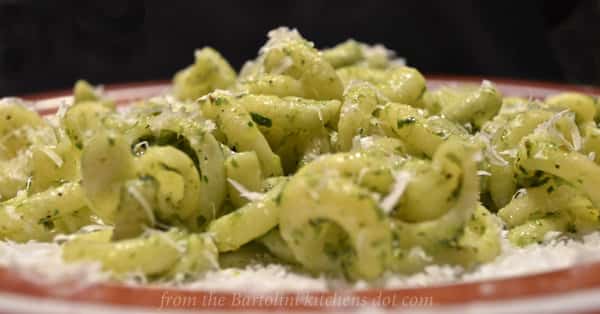
Vesuvio Pasta with Ramps Pesto
Ramps Pesto
Ingredients
- 2 bunches (approx 7 oz or 200g) fresh ramps
- 3 tbsp walnuts , toasted
- 3 tbsp Grana Padano , grated – Parmigiano Reggiano or Pecorino Romano may be substituted
- Olive oil
- Sea salt and pepper , to taste
Instructions
- Prepare the ramps: Wash and thoroughly dry the leaves. Trim away the bottom roots of each bulb, much like you do with spring onions/scallions. Cut off and roughly chop each ramp bulb, then roughly cut or hand tear the leaves and stems.
- Add the bulbs and walnuts to a food processor. Process until a thick paste develops, about a minute. Be sure to scrape down the sides of the bowl midway through.
- Add the ramp leaves, cheese, salt, and pepper to the food processor bowl. Process until evenly combined.
- With the processor still running, add olive in a slow steady stream until the pesto is the consistency your prefer. (See Note)
Notes
Nutrition
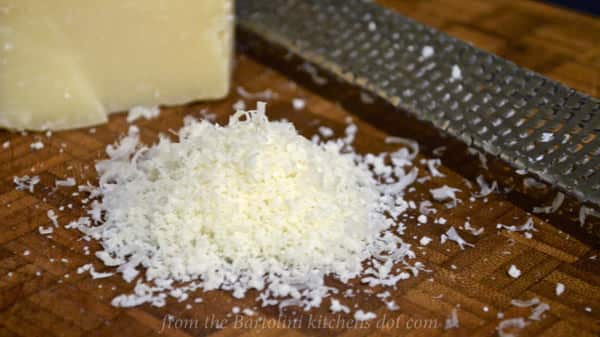
A few words about the cheese
Grana Padano is a hard cheese made from cow’s milk, much like Parmigiano Reggiano. Grana Padano, however, is made using skim milk and is produced in a broad area of Northern Italy, whereas Parmigiano Reggiano uses both skim and whole milk and is created in a much smaller area.
Because the Parmigiano Reggiano region is so much smaller, the cows graze in pastures that are more uniform, creating a more distinctive — and expensive — cheese.
Those with better palates than mine will make note of subtle differences in taste between the two cheeses. I cannot detect the difference, especially when used in a recipe like pesto.
So, why did I use Grana Padano here? That’s an easy one. It was on sale at the market.
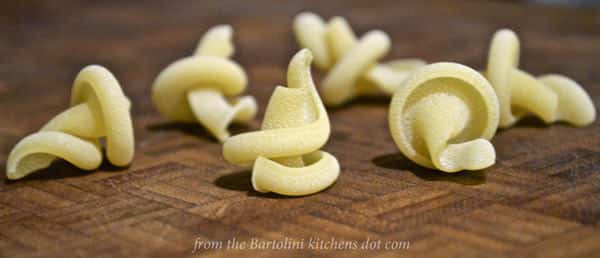
A few more words about the pasta
I had another pasta in mind for this post but, as luck would have it, I couldn’t find it. Instead, I chose “Vesuvio (Napoli)” pasta. This pasta originated in Campania and is said to resemble Mt.Vesuvius. Yes, that Vesuvius.
What’s this? You don’t see the volcano? Not to worry. There are those that claim the pasta looks like Naples and its harbor. How can you not love a people with this kind of imagination when it comes to naming their food?
Because of it’s shape, sauces have no trouble clinging to Vesuvio pasta. This particular brand, however, goes one step further.
Unlike other manufactured pastas, this one was formed by being passed through a bronze plate. “Trafilata al Bronzo” is the name for the process and the resultant pastas are considered artisanal.
The advantage of the method is that the pastas are more rustic and not quite as smooth as others, meaning that sauces are even more likely to cling and hold on to them.
It’s déjà vu all over again …
Although I did mention one ramps recipe earlier, I saved the best for last. For today’s blast from the past, I’ll send you to my favorite ramps recipe—Ramps Ravioli with Morel Mushrooms.
In it, ramps are combined with spinach and ricotta cheese to fill ravioli, which are then served with a sauce prepared with morel mushrooms. You can learn how to prepare this sensational dish by clicking on the recipe title, the photo, or HERE.
Coming not too soon to a monitor near you … Handmade Garganelli
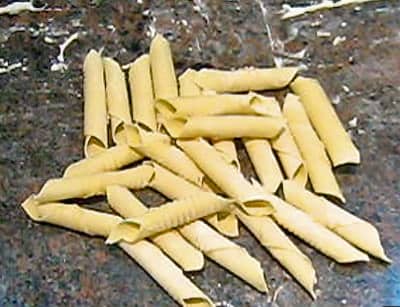
Handmade Garganelli
The Final Word
Thanks again, Judy, for offering me this chance to lend a hand. I hope it won’t be much longer before you’re fully recovered and back at the helm of this, your fantastic blog.
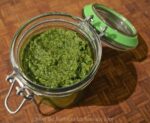
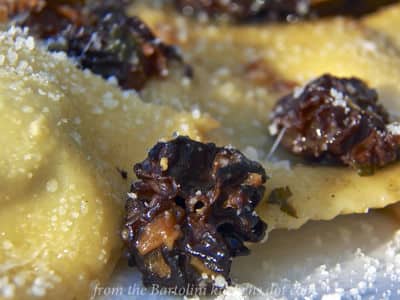
Emily Kemp says
This pesto recipe sounds so delicious, I always look forward to wild garlic coming into season!
Cecile says
How wonderful of you Judy to include your fellow bloggers most recent recipes. I was so very pleased !!
Judy Purcell says
Hi Cecile, thanks for stopping by and saying hello. Hope to see you around more often. 🙂
Cecile says
Hi My Friend ! As always – a great post! I always love your stories and all the information you pack in about different kinds of Italian cuisine. I hope WordPress has solved your problem by the time you get back from Michigan.. Have a great time with Zia !!!
Promenade Claire says
And hello Judy, lovely to meet you and I don’t know how I’ve managed to miss your blog before now! It’s good to hear you are well on the way to recovery, and that you have such good friends around you. Take care, Claire
Judy Purcell says
Hello Claire, so nice of you to stop by and say hello! Thank you too for your well wishes! 🙂
Promenade Claire says
enjoying the touch of history and the smelly onion naming ……… nothing better than fresh pesto is there?!
ChgoJohn says
Just wanted to thank you again, Judy, for giving me this opportunity. I hope your recovery is proceeding quickly and that it won’t be long before you’re back at 100%. Take care.
ChgoJohn says
Hello, MJ, and thanks for the compliments. I’m not so sure that you’ll be able to find ramps in the Southwest. They’ve such a short season, limited range, and short shelf-life that i doubt many are shipped, other than for restaurants. I’d compare it to the vast variety of chiles you have access to that we here never see. I do think, however, that you could make a great pesto with Spring garlic or baby leeks. That’s something for me to try when I get back. 🙂
mjskit says
I’ve never had ramps before or at least I don’t think I have. Definitely will be trying to find some. I love pestos because they really bring out the flavor of the “green” that you use and of course, a pasta sauce ! 🙂 Thanks for the information about using ramps. I needed that. Now to find some. Wonderful guest post as always. Hope you’re feeling better every day Judy!
Simone says
I never even heard of ramps to be honest but it sounds to interesting. And thanks for explaining the difference between grana padano and Parmesan… I’ve always wondered about that. Lol…
ChgoJohn says
Hello, Simone. Ramps aren’t grown everywhere and their season is a short one. I’ve not heard of them being grown on farms – not yet anyway. Until they figure out a way to grow them commercially, they will be hard to come by. As for the cheeses, the difference in taste is so slight that I say, save your money. Get the Grana Padano. 🙂
tableofcolors says
I wonder if ramps could be found in the Nordic countries…I’ll have to look for them and if I can’t find them see if baby leeks might be available. Your recipe looks delicious. Your trip sounds quite exciting…enjoy your time!
ChgoJohn says
I’m not so certain that ramps, as least this variety, can be found outside of North America. From what others have said, though, Europe has wild garlic and it looks very similar. I bet it could be substituted without any problem. Remember that basil or parsley can be used to even the flavor, if need be. Thank you for the vacation well-wishes. It will be quite the trip. 🙂
Carol at Wild Goose Tea says
Bon Voyage!! I saw that heart felt, but I will admit tinged with a bit of envy. I am with the crew that had previously never heard to ramps. Will know this make me a more popular dinner guest? Lol. I did pop over and looked at the ravioli with morels. I have picked these in the past, but no longer live in the area where I know I can find them hiding in their secret places. More in Chanterelle country now. Those are the only two mushrooms that I can safely pick. Anyway I lusted after the ravioli recipe. The pesto is a winner too. What a fun blog. Thank you for sharing your interesting knowledge.
ChgoJohn says
Hello, Carol. Thanks for the vacation well-wishes and compliments. I’m no mushroom picker. Similar to you, I know morels and puffballs. Beyond that, the only picking I do is the mushroom bin at the market. As it is, our secret morel patch is no more. The property has been sold and being landscaped. I don’t think the new owners know what they’re missing.
Unless you live in the East of North America, ramps will be even harder to find. They’ll have to be shipped in. They’ve grown so much in popularity and, with restaurants taking their share, there aren’t that many for transport. Spring garlic, being so mild, is a good substitute, though I do hope you can find some. Good luck!
Eva Taylor says
What a beautiful introduction and not at all surprising that Judy selected you as a guest blogger. I’m really glad you rescheduled the other pasta post to feature ramps, up until I started reading blogs I had never heard of them. I can only imagine how tasty this pesto is. I also loved the tip about the cheese, that revelation will save us some money since I use a lot of Parmesan in cooking.
I hope you have a wonderful time in Europe, happy 60th! I can’t wait to read about your adventures and what you’ll cook up with Zia upon your return. I’m not much if an Instagram user but I’ll definitely pop into twitter to check up on you. Be safe my friend and have a wonderful trip.
BTW, when I clicked the link to Judy’s blog (on my iPhone) I was only able to see the advertising not the post, eventually I was able to circumvent and travel here through the Italian category.
ChgoJohn says
Thank you so much, Eva. If you’re not already a follower, I think you’ll find that Judy’s is a wonderful blog, much like yours. I was surprised to learn that Grana Padano is just as popular in Italy as Parmigiano. The difference in taste is minimal, at least to me, and the main reason is the cost, as you noted.
Thanks, too, for the vacation well-wishes. I’m very much looking forward to seeing my Zia, her daughters, and their families. It’s been at least 45 years. That visit is sure to be the highlight of my trip and my entire family here is excited about it.
Almost forgot. I checked the link, using my iPhone and iPad. I didn’t experience any problems at all. Maybe WordPress burped? See you on Twitter, Eva. 🙂
Norma Chang says
Hopped over from Chgo John and am glad to find your blog, will be visiting again.
Love the ramp recipe John, saving for when I find some ramp.
Have a great trip, sorry I will not be able to follow your trip as I have neither twitter nor instagram. Give my best regards to Zia when you return to the states.
ChgoJohn says
Glad you hopped over, Norma. You’ll love Judy’s blog. You’ll see. 🙂
I do hope you find some ramps. I bet you’ll make a great stir-fry with them. I cannot wait to read about it. Take care and I’ll “see” you in several weeks.
Kristy says
Oh where to start! First, hi Judy. I hope that your recovery is going well and will be speedy!
John – this is a great recipe. I’ve got to keep my eyes open for ramps. I’ve always wanted to try them. Last year, as you know, I was able to score some morels and oh my goodness! Now, the morel and ramp combo has got me really excited. That would be amazing! This pesto, as any pesto, would be welcomed on our tables.
Enjoy all of your travels and I’ve followed you on Instagram. I look forward to seeing a few pics!
Judy Purcell says
Hi Kristy, it is nice to have you stop by Savoring Today and I really do appreciate your well wishes, thank you! 🙂
ChgoJohn says
Hey, Kristy. if you’re going to find ramps, this is the time to do so. If you go to farmers markets, you have to get there early lest the restaurants grab them all. ((I know. You’ve nothing to do but get to the markets first thing in the morning.) I’ve been lucky to get mine through a CSA (Fresh Picks). I was hoping to get morels, too, but I think I’ll miss ’em this year. Dash the luck, eh?
Abbe@This is How I Cook says
How nice to find a new blog and it is always fun to get a new recipe from you, John. I am always on the lookout for ramps so maybe this will be the year. And those pasta shapes? It’s no wonder that Italians have such a history in art. Just look at what they do to pasta! Have a fantastic trip, John. Please make sure to gain 5lbs for me!
ChgoJohn says
Thank you so much, Abbe. I hope you do find ramps. I’d love to see what you’d do with them. Ye, this pasta is oddly shaped. One of my favorite things to do in Italy is to go into a “pasta shop” and just look at all of the shapes that they have. It’s far more that we have here. This time I’m bringing the camera.I’m starting the trip with a visit with my Aunt. I’ll have gained 5 lbs long before I leave her home. 🙂
betsyb says
As always, a wonderful post, John. I think I would love the ramp pesto and I’ll have to be on the lookout for ramps. Have only seen them rarely here. Have a wonderful time in Italy!
Judy, I do hope you continue to recover quickly and smoothly. Have missed getting out and about to read everyone’s posts lately. Very best wishes to you.
ChgoJohn says
Hey, Betsy! Thanks for the compliments. Ramps still might be available in your area. Your Spring wasn’t at all normal, much like ours, and perhaps they got a late start. Your best bet is at a farmers market, I would imagine. Good luck!
Thanks for the vacation wishes. I’m looking forward to this trip!
Judy Purcell says
I know what you mean about missing posts, I have missed many too. Thank you, Betsy, for your best wishes. 🙂
global garnish geek says
John – What a nice idea. Love your post. And the lovely photos look so beautiful on her page – with all the green fonts 🙂 And it is ramps season, isn’t it? Also very nice 🙂
ChgoJohn says
Thank you so much. Seeing my post on this theme has given me pause. I wonder what it would take to convert it? Hmmm …
Yes, it is ramps season and I’m loving it. I’ve more on order and hope to find even more this Saturday at the reopening of our farmers markets, though I’ll have to be there right at opening time if I want to get any ramps. That’s OK. I’ll bring my cane and muscle my way. 🙂
Laura says
Great post John! I love ramps/wild leeks. They grow like mad here in Germany in the woods and surrounding areas and right now they are really easy to get a hold of in the markets. I may have to try making a pesto with them this year! Enjoy your trip to the homeland!
ChgoJohn says
They apparently grow in great enough numbers to support festivals in a number of communities. I’ve gone looking for them but never found them. Finding them at the CSA was fantastic. I hope you do give this pesto a try. It’s a bit different from the “normal” alla Genovese but it’s good. Thanks for the well-wishes. I’m sure to have a good time.. 🙂
ChgoJohn says
I hope you can find the, Margot. There’s so much that you can do with them and they have their own unique flavor. This pesto is proof of that. You certainly won’t think it Pesto alla Genovese.
These days, all I can do is sit and dream of those cappuccinos on a piazza. I’ll be sure to tip my cup eastward on a sunny afternoon in Florence. Thanks for the well-wishes.
Margot (Gather and Graze) says
I’ve not heard of ramps before either John… but they sound like they have such an interesting flavour. I’ll have to ask around at our Farmer’s Market to see if anyone grows them locally.
So excited for you to be heading off to Italy on holidays. Your comment on my last post about drinking coffee in Piazzas makes even more sense now – enjoy a cappuccino for me too! 🙂
EllaDee says
ChgoJohn never fails to impress, and tantalise my tastebuds… a cross between leeks and garlic made into a pesto with walnuts… I can think of quite a few ways I’d could devour this.
ChgoJohn says
You are too kind, EllaDee, and I’m very appreciative. I’ve got more ramps coming this week and I’m trying to decide how to use them. My departure date is fast approaching, so, whatever I do, it has to be quick and store-able, (Nice word, eh?) I’ll work it out and with a little luck, get a post, too. 🙂
Debra says
I’ve never seen Vesuvio pasta, John. What a fun shape, and I can see how the sauce would definitely cling nicely! I remember your ramps from last year and they fascinate me. I have never seen them in our climate, and I have no idea why! I do see that they are similar to wild garlic, which we do have, but I don’t think we’re talking about the same thing! I must do more research here, because the pesto really appeals to me. Ii am going to see if I can find Grana Padano cheese. I love trying new cheeses and sometimes think I could live on cheese alone. 🙂
Enjoy your birthday adventure, John. Hope you can really enjoy yourself. I’m glad you were able to help Judy out before you took off! And Judy, hope you quickly make a complete recovery!
ChgoJohn says
Hello0, Debra. I bet climate differences prevented ramps from spreading westward. There’s a vast difference between the land back east and the Great Plains. Then there are Rockies to cross. The poor little bulbs never had a chance! 🙂
As I’ve mentioned to others. I think wild garlic would be perfect. Just taste it before adding the olive oil and see if it’s too harsh, which might be a result of strong garlic. If so, lighten it up with some basil or parsley leaves. To be honest, I’m going to look for wild garlic at my farmers markets and try it for myself.
Thanks, too, for the well-wishes. I am so looking forward to seeing my family. It’s been at least 45 years since we were last together. That’s going to be some first dinner! 🙂
Judy Purcell says
Thank you, Debra, for your well wishes for a quick and complete recovery, I am doing very well. 🙂
Lizzy (Good Things) says
Thank you for the introduction to John and Bartolini kitchens. Sounds like the kind of blog I enjoy. Being in Australia, ramps are new to me… heading to google them now! Happy cooking.
ChgoJohn says
Hello, Liz. I doubt that ramps are available Down Under but, on the other hand, Google may be able to give you worthwhile Aussie substitutes. Ramps are a Spring vegetable so you’ve some time yet. Good luck!
Hotly Spiced says
I wish I could try ramps! I’ve never seen them here in Oz. I guess they don’t grow here and with ramps having to be used so quickly, they wouldn’t survive the journey to Sydney. Such a shame because your ramp pesto with its beautiful green colour and slight leek flavour looks lovely as does the pasta. I have a bad case of food envy! Great recipe John and I hope you have a wonderful break and I’ll look forward to seeing you on your travels via Instagram xx
ChgoJohn says
Hi, Charlie. I bet you’re right. Ramps would never make it from our East coast to your shores in time. When all is said and done, they are little more than onions and hardly worth the expense to bring them to you. Try using baby leeks next Spring. I bet they’d be really good.
If you haven’t used it already, look at the packaging for the penne that you spotlighted in your IMK post. It will say that the penne was “Trafilata al Bronzo”, just like my vesuvio pasta was. Your penne is even more special than you thought. 🙂
PS … I’m not psychic. I enlarged you photo when I thought I recognized the words on the package.
Lidia Spagnuolo says
Well done John! Both with that pesto and your writing. Not to mention those photos. They are gorgeous. You know, I’ve never had ramps before. I’ve just added it to my mental list of things to try. The colour of that pesto is pure perfection. Love it. Have a wonderful time in Italia, enjoy the food, the wine, and of course your family. Ciao! xox
ChgoJohn says
Grazie mille, Lidia! See that? Only a couple thousand more words and I’ll be conversant.
You really are too kind. Considering how far behind your Spring is this year from ours, you probably have a good chance of finding ramps at your farmers markets. Around here, they’re in high demand so try to get there early.
Thanks for the vacation wishes. I’ll do my very best to make them all come true. Trust me. 🙂
Chica Andaluza says
Gorgeous recipe John – we have a garden full of wild garlic. Not quite ramps but I’m feeling inspired. And I love that Chicago might have been named after smelly onions….how funny! Hope it’s an amazing trip – safe and happy travels 🙂
ChgoJohn says
Thanks, Tanya. I’m sure that you cold make a really good pesto with that wild garlic. You my need to soften it a bit with a little parsley or basil but I bet the result would be wonderful. As for the name, the legend says that there were some many wild onions that even the river smelled of them.
Thanks for the well-wishes. This trip I’ll be staying further North. Maybe next trip we can meet in Calabria. 🙂
Ronit says
As always, John, such a thorough and informative post! The dish looks so very tasty!
Thanks to your guest post, I’ve learned about this blog, which looks wonderful. I will definitely start following it. 🙂
ChgoJohn says
Thank you so much, Ronit. Yes, Judy has a lovely blog and I was quite honored when she asked me to take over a week. If I weren’t leaving on holiday, I might have tried to stick around for a while. 🙂
Nancy says
Delicious sounding pesto, John. No ramps on my property, though I’m thinking a bit of foraging in the area may be successful. Hopefully, it’s not too late here in Michigan. Safe travels to you!
ChgoJohn says
Hi, Nancy. If I can still get locally grown ramps here, you should still be able to get them in Michigan. A trip to Detroit’s Eastern market might be the ticket. Just get there early. Here, the ramps are bought up by the restaurants. Thank you for the well-wishes.
John@Kitchen Riffs says
I love John’s blog! So great to see him guest posting here. And what a great guest post! Ramps are wonderful, although they can be awfully difficult to find (that is, they’re so seasonal, that when you see them you have to grab them). Great tip about Grana Padano — I don’t use that nearly enough, and I should do my own taste testing to see how it compares to Parmigiano Reggiano. Fun (and delicious!) post. Thanks.
ChgoJohn says
You’re too kind, John. Thank you.
With our markets not opening until this weekend, I had doubts that I’d find any ramps this year. And then I saw the CSA’s shopping list. It had both lard and ramps on it, both of which were organic. I bought both and they were my complete order. Maybe I’ll make a ramps quiche with a lard-based crust. 🙂
I’ll be interested to see what you report when you do a taste test of the 2 cheeses. I really couldn’t detect much. I was a smoker for far too many years, I’m afraid.
April @ The 21st Century Housewife says
I really enjoyed your post, John! I love that you called your blog a gift to the next generations – what a wonderful way to look at it! Family recipes and passing them on to the next generations is a real passion of mine.
Anyway, I’ve heard of ramps but never known how to prepare them – your pesto looks scrumptious. I’m definitely going to keep my eye out for some of these delicious vegetable treats.
Have a wonderful trip to Italy!
ChgoJohn says
Hello, April. I’m glad you liked the post and the concept behind my blog. As the ranks of my family’s oldest generation grew thinner, we lost more and more of the old recipes. Since none of the old cooks ever put a dish in front of me that I didn’t like, I had to do something to stop the hemorrhaging. With Zia’s help, we’ve been able to record many of them.
I hope you can find ramps, not just for this pesto but for all of their other uses. They really are one of early Spring’s great treats. Thank you for the well-wishes. 🙂
Coffee and Crumpets says
Hi John! Hi Judy!
I look for ramps every season here in CO, haven’t found them yet 🙁 I really want to try them and especially in this pesto! I am lover of all pestos… And pasta. I will have a go with young garlic or spring onions.
Have a wonderful holiday, John! I wish you’d arranged a stop over here on your travels! We will miss you,
And Judy, I hope you are feeling better.
Nazneen
ChgoJohn says
Hi, Nazneen!
That would have been some flight for me to go to Italy through Colorado, Nanzeen. That would teach me to use miles for my tickets. That just means our meeting has been postponed a bit, nothing more. 🙂
I don’t think that ramps grow in Colorado. Does wild garlic? That might make a good substitution, a well as Spring garlic or baby leeks. Don’t forget to use parsley or basil to adjust any harsh flavors, if there.
Thanks for the vacation well-wishes. I’ll do my best!
Judy Purcell says
Hi Nazneen, thank you for the well wishes, I’m so glad you stopped by to visit Savoring Today, it is nice to meet a blogging neighbor here in Colorado!
Minnie@thelady8home says
So good to meet you Judy 🙂 Be well soon 🙂
Lovely pesto recipe, as always John! Happy travels. Let me search you on Instagram, I am trying to explore that option as well.
ChgoJohn says
Thanks, Minnie. I’m by no means an Instagram expert, only having just joined a few weeks ago. We’ll learn together! 🙂
Judy Purcell says
Thank you, Minnie, it is good to have you visit Savoring Today and thank you for the well wishes. 🙂
Angeline says
I don’t recall ever seeing ramps here in Northern California, but I plan to look. Delicious recipes!
ChgoJohn says
Thanks, Angeline. I’m not so certain ramps grow out West and they’d have to be shipped in. Others have said, though, that you’ve wild garlic growing and I bet you could just as easily use that instead. Just taste it and see if a little basil or parsley is needed to “round out” the garlicky taste. I guess it will depend upon how strong the garlic is. Good luck!
anotherday2paradise says
That pasta is such an interesting shape. I’ve not seen anything like it in South Africa. The pesto sounds really delicious. Have great trip, John. Judy, I wish you a speedy recovery. Sylvia.
ChgoJohn says
A well-stocked pasta aisle in an Italian market is a wonderful thing to behold, Silvia. As often as I go down this particular store’s aisle, I always find something new. When I saw vesufio, I knew I had to use it. 🙂
Thanks for the well-wishes.
Judy Purcell says
Thank you for the well wishes, Sylvia, I am recovering very well. Glad you stopped by Savoring Today. 🙂
Bam's Kitchen says
Bonjourno John! I have never cooked with ramps before so this recipe is really interesting to me. I agree you need a pasta that can hold on to the flavors for this delicious recipe. Thanks for introducing us to a new blog. Judy, wishing you a speedy recovery. Take Care, BAM
ChgoJohn says
Buona sera, BAM! Ramps probably weren’t as popular when you lived in Michigan like they are now. Once the cooking shows mention something, everybody wants it. You use them like you would onion, garlic, shallots, or leeks. I love them and will get more, if I can. 🙂
Do take some time to check out Judy’s home here. It’s a great blog!
Judy Purcell says
Thank you, BAM, for the well wishes, and glad to see you here to Savoring Today. 🙂
ChgoJohn says
Thanks, Maureen. I bet you would like this pesto. I’ve heard of the festivals, though they say they’re getting almost too popular. We don’t have festivals here and most of our ramps get taken by the restaurants. I was very surprised to see them on the CSA shopping list and bought them. I’ve got more on order, too. I love them and am not about to let this opportunity pass me by.
Maureen | Orgasmic Chef says
When we lived in Tennessee there were several ramp festivals around the state. I’ve never tried ramp pesto but I’m sure I’d love it.
Camilla says
A wonderful post, the pasta looks delicious also. I’m now going looking for ramps!
ChgoJohn says
Thank you. I hope you can find them Here, there is competition with the restaurants. That is why I was lucky to find them. Good luck!
Unpizzicodime says
I definitely should try your Ramp Pesto version… sounds yummy and from distance, I can just imagine the lovely smell! Amazed by the description of the Vesuvio Pasta, I live since 2007 near Naples, but I never found it such a shape, should go out for shopping in Gragnano, probably I will be more lucky! I wish Judy a fast recovery!
ChgoJohn says
Thank you. I did enjoy this pesto very much. It is not like pesto alla Genovese. The vesuvio pasta that I bought was imported from Italy. The package is blue and it says “Gragnano Napoli” on the bag. Yes, I think you’ll find it in Gragnano. 🙂
Good luck!
Judy Purcell says
Thank you, Unpizzicodime, for your well wishes!
Mandy - The Complete Book says
Love John’s blog!
Have a wonderful day.
🙂 Mandy xo
ChgoJohn says
You’re too kind, Mandy. “See” you soon. 🙂
Colline says
As usual, the recipe looks delicious John. I think I will try it with baby leeks – my girls love this vegetable. Enjoy your trip to Italy – I will be checking for pictures on Instagram 🙂
ChgoJohn says
I think that baby leeks will work nicely. Just have some basil or parsley leaves necessary in case you need to adjust the leek flavor. Baby leeks are usually pretty mild but you might get a strong one. Thanks for following on Instagram. I hope to see you there. 🙂
Silver Screenings says
Mmm! Walnuts would be a wonderful mix in the pesto. This is a fab recipe – tasty and simple.
Have a wonderful vacation – and happy birthday!
ChgoJohn says
Thanks, Ruth. You’re right. This is one easy recipe — once you find the ramps. It’s worth the effort looking for them, though. Thanks for the well-wishes. I’ll “see” you soon.